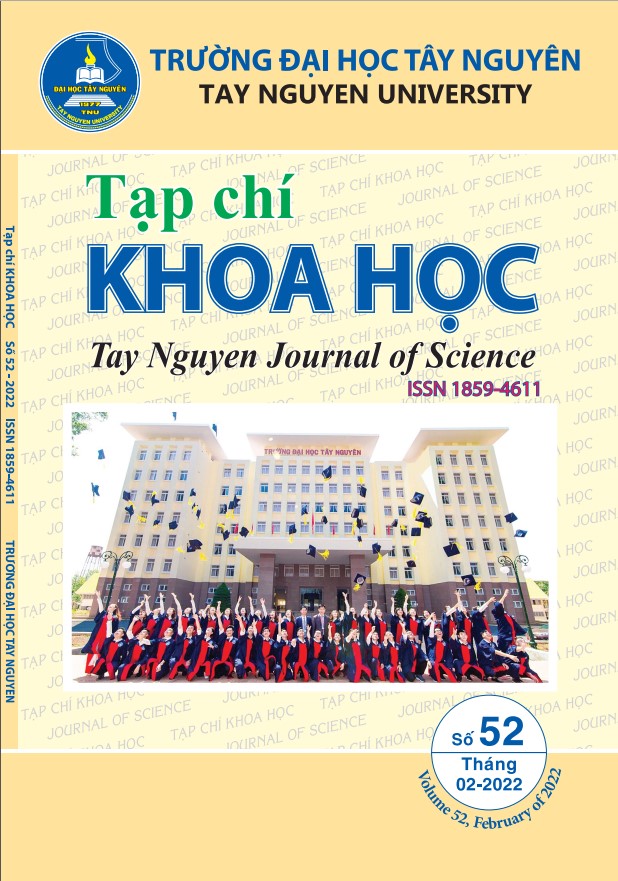Đánh giá hiệu quả của nấm tím Peacilomyces sp. trong phòng trừ loài rệp sáp hại rễ cây hồ tiêu tại Đắk Lắk
Main Article Content
Đánh giá hiệu quả của nấm tím Peacilomyces sp. trong phòng trừ loài rệp sáp hại rễ cây hồ tiêu tại Đắk Lắk
Tóm tắt
Rệp sáp gây hại rễ là loài sâu hại nguy hiểm hại cây hồ tiêu. Rệp sáp hại rễ hồ tiêu sống trong đất và tạo thành “măng xông” khi gây hại nặng nên rất khó phát hiện và phòng trừ bằng biện pháp hóa học. Nấm tím Paecilomyces sp. là nấm ký sinh côn trùng, thường sống trong đất và đã được nghiên cứu ứng dụng trong phòng trừ nhiều loài sâu hại cây trồng. Nghiên cứu này nhằm phân lập, tuyển chọn và đánh giá hiệu quả của một số chủng nấm tím Paecilomyces sp. đối với rệp sáp hại rễ cây hồ tiêu tại tỉnh Đắk Lắk. Kết quả của nghiên cứu đã phân lập và xác định được 4 chủng nấm tím Paecilomyces sp. có khả năng ký sinh rệp sáp hại rễ cây hồ tiêu tại Đắk Lắk bao gồm PB1, PB2, PB3 và PL4. Trong đó chủng PB1 có khả năng ký sinh mạnh nhất ở cả hai giai đoạn ấu trùng rệp và rệp trưởng thành. Trong phòng thí nghiệm, nồng độ dung dịch bào tử chủng nấm PB1 ảnh hưởng lớn đến tỷ lệ ấu trùng và rệp trưởng thành chết. Mức nồng độ 1x109 (bào tử/ml) gây tỷ lệ rệp sáp hại rễ hồ tiêu chết vì ký sinh sinh đạt cao nhất ở hầu hết các lần theo dõi.
Article Details
Tài liệu tham khảo
- Nguyễn Thị Chắt (2008). Rệp sáp hại cây trồng và biện pháp phòng trị. Nhà xuất bản Nông nghiệp, TP. Hồ Chí Minh.
- Chi cục trồng trọt và bảo vệ thực vật tỉnh Đắk Lắk (2020). Thực trạng sản xuất năm 2020 và định hướng phát triển cây Hồ tiêu trong thời gian tới.
- Brand, D., Roussos, S., Pandey, A., Zilioli, P. C., Pohl, J., & Soccol, C. R. (2004). Development of a bionematicide with Paecilomyces lilacinus to control Meloidogyne incognita. Applied biochemistry and biotechnology, 118(1), 81-88.
- Castillo Lopez, D., Zhu-Salzman, K., Ek-Ramos, M. J., & Sword, G. A. (2014). The entomopathogenic fungal endophytes Purpureocillium lilacinum (formerly Paecilomyces lilacinus) and Beauveria bassiana negatively affect cotton aphid reproduction under both greenhouse and field conditions. PloS one, 9(8), e103891.
- Devasahayam, S., Koya, K. A., Anandaraj, M., Thomas, T., & Preethi, N. (2009). Distribution and ecology of root mealybugs associated with black pepper (Piper nigrum Linnaeus) in Karnataka and Kerala, India. Entomon, 34(3), 147-154.
- Demirci, F., & Denizhan, E. (2010). Paecilomyces lilacinus, a potential biocontrol agent on apple rust mite Aculus, schlechtendali and interactions with some fungicides in vitro. Phytoparasitica, 38(2), 125-132.
- Dube, B., & Smart Jr, G. C. (1987). Biological control of Meloidogyne incognita by Paecilomyces lilacinus and Pasteuria penetrans. journal of nematology, 19(2), 222.
- Gökçe, A., & Er, M. K. (2005). Pathogenicity of Paecilomyces spp. to the glasshouse whitefly, Trialeurodes vaporariorum, with some observations on the fungal infection process. Turkish Journal of Agriculture and Forestry, 29(5), 331-340.
- Hoang Chinh Nguyen, Thi Van Anh Tran, Quoc Linh Nguyen, Nhu Nhut Nguyen, Minh Khiem Nguyen, Ngoc Thanh Tam Nguyen, Chia-Hung Su, Kuan-Hung Lin, (2017). Newly Isolated Paecilomyces lilacinus and Paecilomyces javanicus as novel biocontrol agents for Plutella xylostella and Spodoptera. litura. Notulae Botanicae Horti Agrobotanici Cluj-Napoca, 45(1), 280-286.
- Humber, R. A. (2012). Identification of entomopathogenic fungi. Manual of techniques in invertebrate pathology, 151-187.
- Kepenekci, I., Atay, T., Oksal, E., Saglam, H. D., Tulek, A., & Evlice, E. (2015). Identification of Turkish Isolate of the Entomopathogenic Fungi, Purpureocillium lilacinum (syn: Paecilomyces lilacinus) and its Effect on Potato Pests, Phthorimaea operculella (Zeller)(Lepidoptera: Gelechiidae) and Leptinotarsa decemlineata (Say)(Coleoptera: Chrysomelidae). Egyptian Journal of Biological Pest Control, 25(1).
- Kiewnick, S., & Sikora, R. A. (2006). Biological control of the root-knot nematode Meloidogyne incognita by Paecilomyces lilacinus strain 251. Biological control, 38(2), 179-187.
- Kumar, C. S., Jacob, T. K., Devasahayam, S., Geethu, C., & Hariharan, V. (2021). Characterization and biocontrol potential of a naturally occurring isolate of Metarhizium pingshaense infecting Conogethes punctiferalis. Microbiological Research, 243, 126645.
- Khanzada, A. M., Khanzada, M. A., Syed, R. N., & Lodhi, A. M. (2021). Comparative effectiveness of entomopathogenic fungi against okra mealybug Phenacoccus solenopsis. Pak. J. Bot, 53(1), 287-292.
- Luangsa-Ard, J., Houbraken, J., van Doorn, T., Hong, S. B., Borman, A. M., Hywel-Jones, N. L., & Samson, R. A. (2011). Purpureocillium, a new genus for the medically important Paecilomyces lilacinus. FEMS microbiology letters, 321(2), 141-149.
- Najitha U., Susannamma K., Mathew M.P, Anjana C., (2018). Root melybugs and associated fauna in black pepper. Indian Journal of Entomology. Vol. 80 (3): 922-925.
- Samson, R. A. (1974). Paecilomyces and some allied hyphomycetes. Studies in mycology, 6, 1-119.
- Sanjaya, Y. (2016). Pathogenicity of three entomopathogenic fungi, Metarhizium anisopliae, Beauveria bassiana, and Paecilomyces lilacinus, to Tetranychus kanzawai infesting papaya seedlings. Arthropods, 5(3), 109.
- Wakil, W., Ghazanfar, M. U., Kwon, Y. J., Ullah, E., Islam, S., & Ali, K. (2012). Testing Paecilomyces lilacinus, diatomaceous earth and Azadirachta indica alone and in combination against cotton aphid (Aphis gossypii Glover)(Insecta: Homoptera: Aphididae). African Journal of Biotechnology, 11(4), 821-828.



